Introduction to Potassium
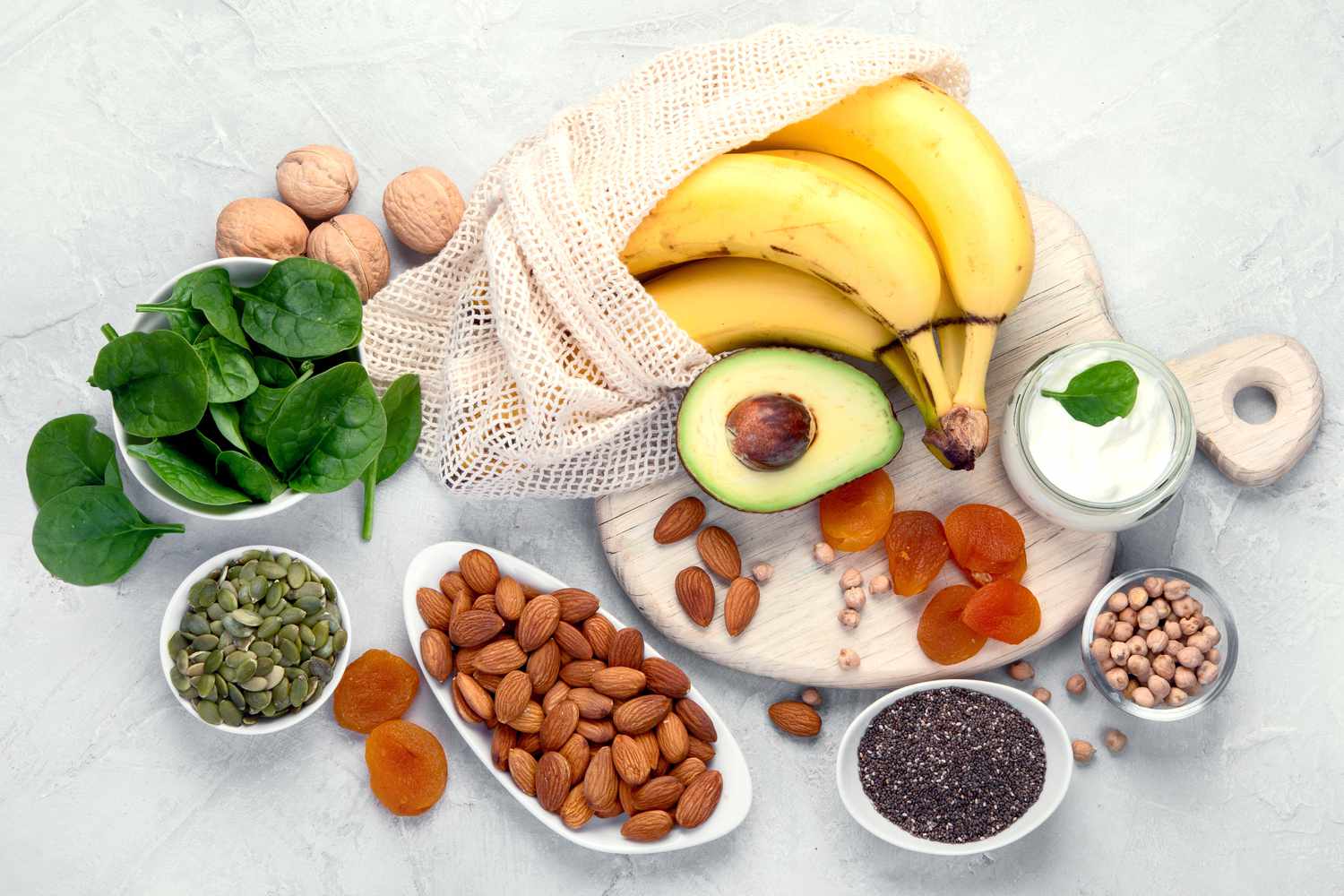
Source: health.com
What is Potassium?
Potassium stands as one of the most vital minerals your body needs to function properly. This electrolyte plays a crucial role in numerous bodily processes that keep you healthy and thriving. Unlike some nutrients, potassium is not something your body can produce on its own. You must obtain it through the foods you eat, making dietary choices particularly important for maintaining optimal potassium levels. [#1]
At its core, potassium is an essential mineral that helps regulate fluid balance, muscle contractions, and nerve signals throughout your body. [#2] Without adequate potassium, these fundamental processes can become compromised, potentially leading to various health issues.
Importance of Potassium in the Diet
Including sufficient potassium in your daily diet offers numerous health advantages. This mineral works in tandem with sodium to maintain proper fluid balance inside and outside your cells. This balance is critical for:
- Proper nerve function and transmission
- Muscle contraction, including your heartbeat
- Kidney function and waste removal
- Blood pressure regulation
- Nutrient transport into cells
Many people don’t realize that potassium and sodium work as a team in your body. While sodium tends to increase blood pressure, potassium helps lower it. Finding the right balance between these two minerals represents a key factor in maintaining cardiovascular health.
Unfortunately, the typical Western diet often contains too much sodium and insufficient potassium—exactly the opposite of what promotes optimal health. By focusing on potassium-rich foods, particularly fruits, you can help correct this imbalance and support your overall wellbeing.
Potassium in the Human Body
Your body contains approximately 98% of its potassium inside your cells, with only a small amount circulating in your bloodstream. This distribution highlights how critical potassium is for cellular function. The concentration gradient of potassium (high inside cells, low outside) helps generate the electrical charges necessary for nerve impulses, muscle contractions, and heart rhythm.
The kidneys play a major role in regulating potassium levels, excreting excess amounts to maintain the precise balance your body needs. When potassium levels fall too low—a condition called hypokalemia—you might experience muscle weakness, fatigue, cramping, or irregular heartbeats. Conversely, excessively high levels (hyperkalemia) can cause dangerous heart rhythm abnormalities.
Given that your body cannot manufacture potassium, consuming a variety of potassium-rich foods becomes essential for maintaining appropriate levels of this mineral. Fruits represent one of nature’s best sources of dietary potassium, offering this vital nutrient in a delicious, easily digestible package that comes with additional health benefits from fiber, vitamins, and antioxidants.
Health Benefits of Potassium
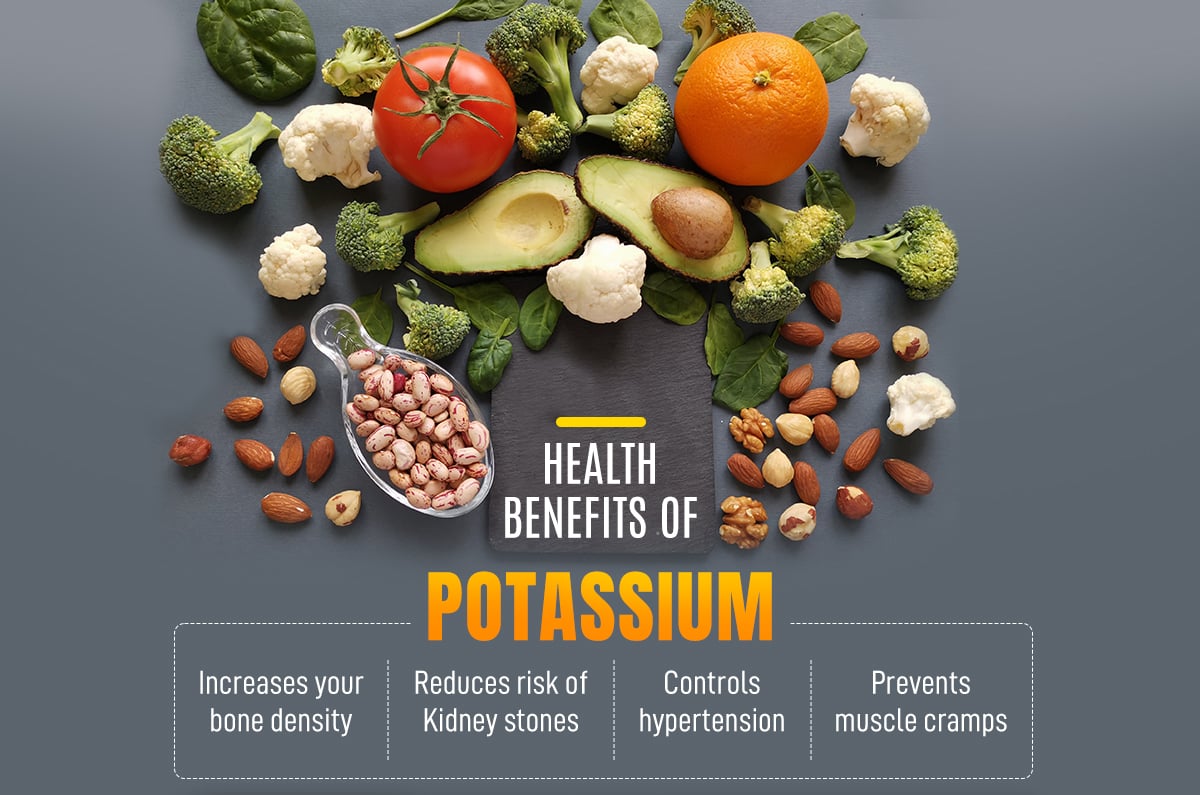
Source: kokilabenhospital.com
Potassium and Blood Pressure Control
One of the most significant health benefits of potassium is its ability to regulate blood pressure. This mineral works as a natural counterbalance to sodium in your body. While sodium can increase blood pressure by causing your body to retain water, potassium helps flush excess sodium through your urine and eases tension in your blood vessel walls. [#3]
Research consistently shows that diets rich in potassium can help lower blood pressure, especially in people with hypertension. This blood pressure-lowering effect is particularly important because high blood pressure is a major risk factor for heart disease and stroke—two of the leading causes of death worldwide.
The mechanism behind potassium’s blood pressure benefits is multifaceted:
- It promotes sodium excretion through the kidneys
- It helps relax blood vessel walls, reducing resistance to blood flow
- It improves overall vascular function
- It decreases the sensitivity of blood pressure to salt intake
For those already managing hypertension, increasing potassium intake through fruits and other potassium-rich foods can serve as a natural complement to medication and other lifestyle changes. Some studies suggest that the blood pressure-lowering effects of potassium are most pronounced in people who consume high amounts of sodium or who have salt-sensitive hypertension.
Other Health Benefits
Beyond blood pressure regulation, potassium delivers numerous other health advantages that make it truly essential for overall wellness. Your nervous system relies heavily on potassium to function properly. This mineral facilitates the transmission of electrical signals throughout your body, allowing your brain to communicate with muscles and organs. Without adequate potassium, nerve signaling becomes compromised, potentially leading to tingling sensations, numbness, or even muscle weakness.
Heart health benefits from potassium extend beyond blood pressure control. This mineral helps maintain a regular heartbeat by supporting proper electrical activity in your heart muscle. Irregular heartbeats, known as arrhythmias, can sometimes be linked to potassium imbalances. By maintaining optimal potassium levels, you help your heart beat with the steady rhythm necessary for efficient circulation.
Your kidneys also benefit substantially from adequate potassium intake. This mineral supports kidney function by:
- Enhancing calcium absorption, which may reduce kidney stone formation
- Supporting proper fluid balance throughout the body
- Helping filter waste products more efficiently
- Potentially slowing the progression of kidney disease in some cases
Research indicates that potassium improves how your kidneys handle calcium, potentially reducing the risk of developing painful kidney stones. This protective effect appears particularly strong when potassium comes from fruits and vegetables rather than supplements.
Bone health also receives a boost from potassium. Some studies suggest that diets rich in potassium may help preserve bone mineral density, particularly in older adults. This benefit likely stems from potassium’s ability to neutralize acid loads that can leach calcium from bones. By maintaining a more alkaline environment, potassium-rich foods may help protect against osteoporosis and fractures.
The combined benefits of potassium on cardiovascular health, kidney function, and bone density make it a crucial component of any health-focused diet. By incorporating more potassium-rich fruits and other foods into your daily meals, you’re supporting multiple body systems simultaneously with a single dietary change.
High Potassium Fruits and Foods
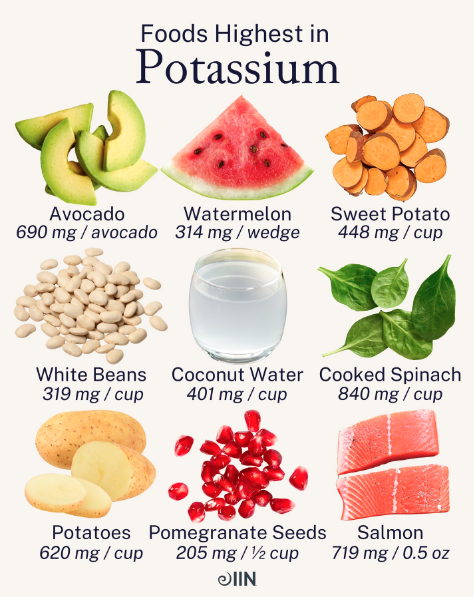
Source: integrativenutrition.com
Top Fruits High in Potassium
Nature has provided us with an abundance of delicious fruits packed with potassium. These natural treats offer a convenient and tasty way to boost your potassium intake while enjoying a sweet snack. Let’s explore some of the most potassium-rich fruits available.
Bananas are perhaps the most well-known potassium powerhouse. One medium banana delivers approximately 451 mg of potassium, making it an excellent portable snack option. This convenient fruit can be easily added to smoothies, oatmeal, or simply enjoyed on its own for a quick potassium boost.
Avocados stand out as an exceptional source of this vital mineral. While technically a fruit, avocados offer an impressive potassium content that surpasses many other options. A single cup of mashed avocado (about 150 grams) provides a whopping 1,120 mg of potassium—more than twice the amount found in a banana! This creamy fruit also delivers healthy fats and fiber, making it a nutritional triple threat.
Citrus fruits deserve special attention for their potassium content. Orange juice, for instance, delivers a substantial amount of this mineral, with one cup (248 grams) providing 496 mg of potassium. Fresh oranges, grapefruits, and other citrus varieties also contribute meaningful amounts to your daily intake.
Don’t overlook these other potassium-rich fruits:
- Cantaloupe and honeydew melons
- Apricots (especially dried)
- Kiwi fruit
- Mangoes
- Dried fruits like raisins, prunes, and dates
An interesting option many people don’t consider is coconut water. This refreshing beverage contains about 600 mg of potassium per cup (240 grams), making it an excellent choice for rehydration after exercise while simultaneously boosting your potassium levels.
Other Potassium-Rich Foods
While fruits offer delicious ways to increase potassium intake, a truly balanced approach includes various food groups. Vegetables rank among the most potassium-dense foods available, often providing substantial amounts with fewer calories than many fruits.
Leafy greens deserve a prominent place in any potassium-focused diet. Spinach, particularly when cooked, concentrates its potassium content and becomes an exceptional source of this mineral. Other leafy options like Swiss chard and kale similarly provide significant potassium alongside numerous other nutrients.
Root vegetables and tubers contain impressive potassium levels. Potatoes—whether white, red, or sweet varieties—deliver substantial amounts of this mineral. A medium baked potato with skin can provide over 900 mg of potassium, rivaling or exceeding many fruits. Other starchy vegetables like winter squash and pumpkin also contribute meaningful amounts.
The vegetable kingdom offers numerous other potassium-rich options:
- Broccoli (especially cooked)
- Mushrooms
- Peas
- Cucumbers
- Zucchini
- Eggplant
Beyond fruits and vegetables, several other food categories can help boost your potassium intake. Legumes—including beans, lentils, and chickpeas—provide substantial amounts of this mineral alongside protein and fiber. Fish like salmon and tuna deliver potassium along with heart-healthy omega-3 fatty acids. Even dairy products contribute meaningful amounts, with yogurt and milk serving as good sources. [#4]
Creating meals that combine multiple potassium-rich foods amplifies your intake while providing diverse nutrients. For instance, a spinach salad topped with avocado, chickpeas, and a sprinkle of pumpkin seeds creates a potassium-packed meal with varied textures and flavors. Similarly, a smoothie containing banana, orange juice, and yogurt delivers a substantial potassium boost in a single glass.
The beauty of focusing on potassium-rich whole foods rather than supplements lies in the additional benefits these foods provide. Most potassium-rich foods also deliver fiber, antioxidants, vitamins, and other minerals that work synergistically to support overall health. This comprehensive approach to nutrition maximizes the benefits beyond what any single nutrient can provide.
Daily Potassium Requirements
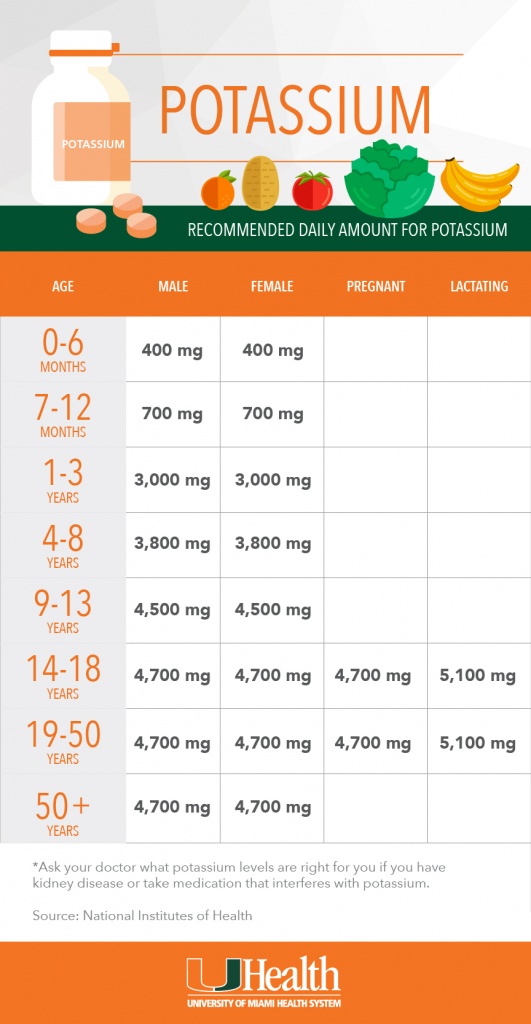
Source: news.umiamihealth.org
Recommended Daily Intake
Understanding how much potassium your body needs is essential for maintaining optimal health. Potassium requirements vary based on several factors including age, sex, and life stage. While general guidelines exist, it’s important to recognize that individual needs may differ.
According to current recommendations in the United States, healthy adults should aim to consume approximately 4,700 mg of potassium daily. This target helps maintain proper electrolyte balance and supports the numerous bodily functions that rely on this vital mineral.
However, more specific guidelines exist based on demographic factors:
- Men over 19 years of age should consume about 3,400 milligrams of potassium per day [#5]
- Women over 19 years of age have a lower recommended intake of 2,600 milligrams daily
- Pregnant or breastfeeding women need additional potassium, with recommendations of 2,800–2,900 milligrams per day
These variations reflect the different physiological needs across populations. Men typically have greater muscle mass and overall body size compared to women, necessitating higher potassium intake. During pregnancy and lactation, women require extra potassium to support both maternal health and the developing baby or milk production.
It’s worth noting that these recommendations represent targets for healthy individuals. People with certain medical conditions—particularly kidney disorders—may need to restrict their potassium intake under medical supervision. Conversely, athletes or those who sweat heavily might require additional potassium to replace what’s lost through perspiration.
Reading Nutrition Labels
Tracking your potassium intake begins with understanding how to interpret nutrition labels. Food manufacturers are now required to list potassium content on nutrition facts panels, making it easier to monitor your consumption of this important mineral.
When examining a nutrition label, look for potassium listed under the minerals section. The amount is typically displayed in milligrams (mg) and as a percentage of Daily Value (%DV). The current Daily Value for potassium is 4,700 mg, so a food providing 10% of the DV contains approximately 470 mg of potassium.
Pay special attention to serving sizes when evaluating potassium content. Nutrition information is always presented per serving, not necessarily per package or container. Many packaged foods contain multiple servings, so you’ll need to adjust the potassium value if you consume more or less than the stated serving size.
Beyond packaged foods, many fresh fruits and vegetables don’t come with nutrition labels. For these items, online databases, mobile apps, or printed nutrition guides can help you estimate potassium content. Some of the most nutritious fruits are particularly rich in potassium, making them excellent choices for meeting your daily requirements.
Creating a mental catalog of high-potassium foods can simplify your shopping and meal planning. With practice, you’ll develop an intuitive sense of which foods contribute significantly to your daily potassium goals without needing to check labels for every item.
A balanced approach to meeting potassium requirements involves consuming a variety of potassium-rich foods throughout the day rather than relying on a single source. This strategy not only helps you reach your potassium target but also provides a spectrum of other nutrients that support overall health.
Remember that cooking methods can affect potassium content. Boiling vegetables, for instance, can cause some potassium to leach into the cooking water. If you’re trying to maximize potassium intake, consider steaming, roasting, or sautéing vegetables instead of boiling them, or use the nutrient-rich cooking liquid in soups or sauces.
While tracking potassium intake is valuable, becoming overly fixated on exact numbers isn’t necessary for most healthy individuals. Focus instead on regularly incorporating potassium-rich whole foods into your diet, and you’ll likely meet your requirements naturally while enjoying delicious, nutritious meals.
Considerations and Precautions
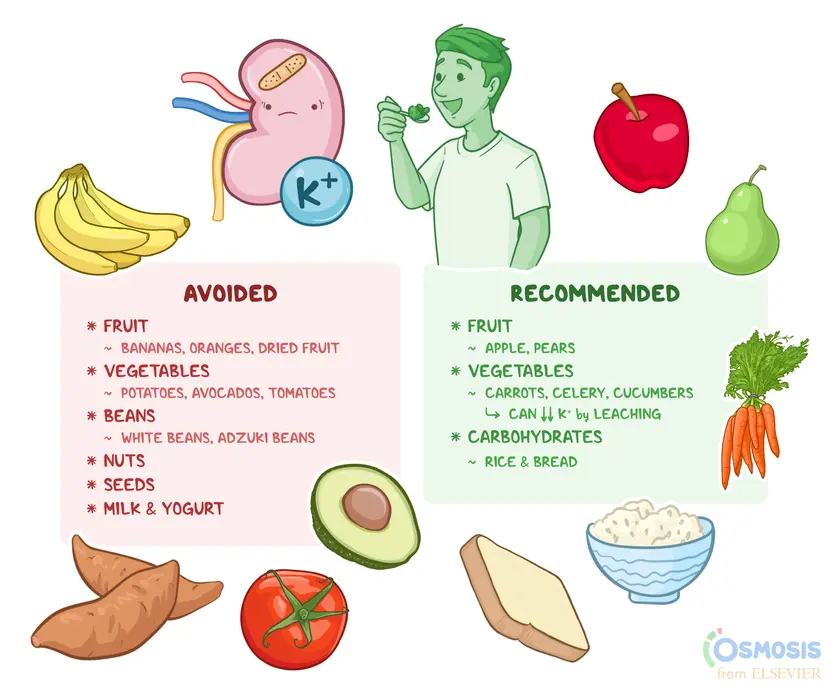
Source: osmosis.org
When to Limit Potassium Intake
While potassium is essential for most people, certain health conditions require careful monitoring and potential restriction of this mineral. Understanding when to limit potassium consumption can be just as important as knowing when to increase it.
Kidney disease stands as the primary reason for potassium restriction. Healthy kidneys efficiently filter excess potassium from the blood and excrete it through urine. However, when kidney function declines, this filtering capacity diminishes, potentially leading to dangerous potassium accumulation in the bloodstream. Some people with kidney disease should consume less potassium than the recommended amount to prevent complications.
If you have kidney problems, your healthcare provider may recommend a low-potassium diet. This typically involves limiting or avoiding high-potassium foods like bananas, oranges, potatoes, and tomatoes. Working with a registered dietitian who specializes in renal nutrition can help create a balanced meal plan that maintains appropriate potassium levels while still providing adequate nutrition.
Several other conditions may warrant potassium monitoring:
- Addison’s disease (adrenal insufficiency)
- Uncontrolled diabetes
- Severe burns or injuries
- Certain medications (particularly some blood pressure medications, diuretics, and immunosuppressants)
Additionally, people taking potassium supplements or potassium-sparing diuretics need to be particularly cautious about their dietary potassium intake. These medications can increase potassium retention, making dietary sources more likely to contribute to excessive levels. Always inform your healthcare provider about all supplements and medications you’re taking to avoid potentially dangerous interactions.
Potential Risks of Excessive Potassium
Hyperkalemia—the medical term for elevated blood potassium levels—can develop when too much potassium accumulates in the bloodstream. This condition rarely results from dietary sources alone in people with normal kidney function. However, it can occur in those with impaired kidney function or other risk factors.
The symptoms of hyperkalemia can be subtle initially but may progress to serious complications if left untreated. Early warning signs include:
- Muscle weakness or fatigue
- Numbness or tingling sensations
- Nausea or vomiting
- Irregular heartbeat or palpitations
- Shortness of breath
In severe cases, hyperkalemia can lead to dangerous heart rhythm abnormalities and even cardiac arrest. This makes prompt medical attention crucial if you experience these symptoms, particularly if you have risk factors for high potassium levels.
Several factors can contribute to hyperkalemia beyond kidney disease. Dehydration concentrates potassium in the blood, while certain medications alter how the body processes this mineral. Other potential causes include high-potassium diets combined with risk factors, unmanaged diabetes, significant injuries, serious burns, and Addison’s disease.
For most healthy individuals, the body efficiently regulates potassium levels, making toxicity from food sources unlikely. However, those with compromised kidney function face greater challenges in maintaining this balance. As the National Kidney Foundation notes, eating too much potassium can be harmful to people with kidney problems. [#6]
If you belong to a high-risk group, regular blood tests to monitor potassium levels are advisable. These tests provide valuable information about how well your body manages potassium and whether dietary adjustments are necessary. Your healthcare provider can recommend an appropriate testing schedule based on your specific health situation.
It’s worth noting that potassium from food sources is generally safer than supplements because it’s absorbed more gradually. This gives the body time to process and eliminate excess amounts. Supplements, by contrast, can deliver large doses quickly, potentially overwhelming the body’s regulatory mechanisms.
The balance between getting enough potassium for good health while avoiding excessive amounts requires awareness of your personal health status. For most people, focusing on whole foods rather than supplements represents the safest approach to maintaining optimal potassium levels. Those with health conditions affecting potassium balance should work closely with healthcare providers to develop personalized nutrition plans that support their specific needs.
Incorporating Potassium-Rich Foods into Your Diet

Source: optimisingnutrition.com
Meal Prep Ideas
Adding potassium-rich foods to your daily meals doesn’t have to be complicated. With some simple planning, you can boost your potassium intake while enjoying delicious and varied meals throughout the week.
Breakfast offers numerous opportunities to incorporate potassium. Try preparing overnight oats with sliced bananas and a sprinkle of chia seeds. Another option is a smoothie bowl featuring spinach, banana, and avocado topped with fresh berries. For those who prefer savory breakfasts, sweet potato hash with bell peppers and onions provides a hearty potassium boost to start your day.
Lunch preparation can be streamlined with batch cooking. Consider preparing a large quinoa salad with roasted vegetables, black beans, and avocado that can last several days in the refrigerator. Mason jar salads layered with leafy greens, chickpeas, colorful vegetables, and a homemade vinaigrette make for convenient grab-and-go options that deliver substantial potassium.
For dinner meal prep, roast a variety of vegetables like potatoes, winter squash, and parsnips on the weekend to use throughout the week. These can be incorporated into grain bowls, added to pasta dishes, or served alongside protein sources. Foods high in potassium are typically high in other nutrients and low in sodium, making them excellent choices for overall health.
Don’t forget about snacks and beverages. Keep dried fruits like apricots or prunes in your desk drawer for a quick potassium-rich snack. Drinks high in potassium include milk, soy milk, and orange juice, which can be consumed throughout the day to help meet your potassium goals.
Simple Recipes
Incorporating potassium-rich ingredients into everyday cooking can be straightforward with these simple recipe ideas:
- Banana Berry Smoothie: Blend one banana, a cup of strawberries, a handful of spinach, and your choice of milk for a potassium-packed breakfast or snack.
- Avocado Toast with Tomatoes: Top whole-grain toast with mashed avocado, sliced tomatoes, and a sprinkle of hemp seeds for a quick meal rich in potassium.
- Sweet Potato and Black Bean Burritos: Fill whole-grain tortillas with roasted sweet potatoes, black beans, spinach, and your favorite toppings for a portable, potassium-rich lunch.
- Mushroom and Potato Soup: Simmer diced potatoes, mushrooms, onions, and garlic in vegetable broth, then blend half for a creamy texture without adding cream. Both mushrooms and potatoes are excellent potassium sources.
- Cantaloupe and Honeydew Fruit Salad: Combine cubed melons with a squeeze of lime juice for a refreshing dessert or side dish packed with potassium.
For a potassium-rich dinner, try a sheet pan meal with salmon, potatoes, and asparagus. Simply season all ingredients with olive oil, lemon juice, garlic, and herbs, then roast until the salmon is cooked through and the vegetables are tender. This one-pan meal minimizes cleanup while maximizing nutrition.
Another easy option is a tomato-based vegetable stew with lima beans, winter squash, and potatoes—all high-potassium ingredients that create a satisfying meal when simmered together with herbs and spices.
For dessert, consider a parfait made with layers of yogurt, sliced nectarines, and a drizzle of blackstrap molasses, which is surprisingly high in potassium. This sweet treat provides multiple nutrients while satisfying your sweet tooth.
Balancing Potassium and Sodium Intake
The relationship between potassium and sodium in your diet plays a crucial role in blood pressure regulation and overall cardiovascular health. Most Americans consume too much sodium and too little potassium—a combination that can contribute to hypertension and heart disease.
To improve this balance, focus on reducing processed food consumption while increasing fresh, whole foods. Processed foods typically contain high amounts of sodium and lower levels of potassium, while the opposite is true for fresh foods. When grocery shopping, spend most of your time in the produce section and the perimeter of the store where fresh foods are typically located.
Reading nutrition labels can help you make informed choices. Look for foods with higher potassium content relative to sodium. The ideal ratio would have more potassium than sodium per serving. Many packaged foods now list potassium content on their nutrition facts panel, making this comparison easier.
In your kitchen, experiment with herbs, spices, citrus juices, and vinegars to add flavor without sodium. These alternatives can make potassium-rich foods more appealing without relying on salt. For example, roasted sweet potatoes taste delicious with a sprinkle of cinnamon and a touch of maple syrup, no salt needed.
When dining out, request that food be prepared with minimal salt and look for menu items featuring fresh fruits and vegetables. Ask for dressings and sauces on the side so you can control the amount used. A side of fresh fruit or a baked potato can boost the potassium content of your restaurant meal.
Remember that gradual changes are often more sustainable than dramatic diet overhauls. Try replacing one processed food item with a fresh alternative each week. Over time, these small shifts can significantly improve your potassium-to-sodium ratio and support better health outcomes.
By thoughtfully incorporating potassium-rich foods into your daily eating patterns and being mindful of sodium intake, you can create a dietary pattern that supports optimal health and wellbeing. The variety of potassium-rich options—from fruits and vegetables to legumes and dairy—means you can enjoy diverse, flavorful meals while nourishing your body with this essential mineral.
Conclusion
Key Takeaways
Potassium stands as one of the most vital minerals for maintaining optimal bodily functions. Throughout this article, we’ve explored how this electrolyte supports heart health, regulates blood pressure, and contributes to proper muscle and nerve function. The good news is that nature provides us with an abundance of delicious options to meet our daily potassium needs.
Let’s recap the most important points about potassium and your health:
- Potassium works in balance with sodium to regulate fluid balance and blood pressure
- Adults should aim for approximately 3,500-4,700 mg of potassium daily
- Fruits like bananas, avocados, and oranges offer substantial potassium content
- Beyond fruits, vegetables such as sweet potatoes, spinach, and tomatoes are excellent sources
- Most Americans consume too little potassium and too much sodium—a combination that can elevate blood pressure
- People with certain kidney conditions may need to limit potassium intake
The relationship between potassium and sodium deserves special attention. While most processed foods tip the balance toward sodium, whole foods typically provide more potassium. By shifting your diet toward fresh produce, legumes, and whole grains, you naturally improve this critical mineral balance without much additional effort.
Reading nutrition labels has become easier with potassium content now listed on many packaged foods. This transparency allows for more informed choices when shopping. Remember that foods providing at least 10% of the Daily Value for potassium can be considered good sources of this mineral.
Final Thoughts
Incorporating potassium-rich foods into your daily routine doesn’t require drastic changes. Small, consistent adjustments often lead to lasting habits. Perhaps start by adding a banana to your breakfast, choosing sweet potatoes instead of regular potatoes, or keeping dried fruits on hand for snacking. These simple swaps can significantly boost your potassium intake over time.
For those concerned about meeting their potassium goals, tracking your intake for a few days can provide valuable insights. Many nutrition apps now calculate potassium content automatically, making this process straightforward. However, focus on the overall pattern of eating rather than obsessing over exact numbers.
While supplements exist, obtaining potassium from whole foods remains the preferred approach for most healthy individuals. Food sources provide potassium alongside fiber, antioxidants, and other beneficial compounds that work synergistically to promote health.
Remember that balance remains key. Too little potassium can affect heart rhythm and muscle function, while excessive amounts—typically from supplements rather than food—may cause problems for those with compromised kidney function. As with many aspects of nutrition, moderation and variety serve as reliable guides.
By prioritizing potassium-rich foods, particularly fruits and vegetables, you’re not just addressing a single nutrient need—you’re supporting comprehensive health. The diverse colors, flavors, and textures of potassium-rich foods make healthy eating both enjoyable and sustainable.
Your journey toward optimal potassium intake represents just one aspect of a balanced approach to nutrition. Combined with adequate hydration, regular physical activity, and attention to overall dietary patterns, maintaining healthy potassium levels contributes significantly to your long-term wellbeing. Nature has provided everything we need—the choice to harness these natural resources for better health remains ours to make.
References
- 1. 14 Healthy Foods That Are High in Potassium
https://www.healthline.com/nutrition/high-potassium-foods - 2. 10 Potassium-Rich Foods – Baptist Health
https://www.baptisthealth.com/blog/healthy-living/potassium-rich-foods - 3. Potassium-Rich Foods: A Comprehensive Guide
https://www.webmd.com/diet/foods-rich-in-potassium - 4. High-Potassium Foods
https://healthy.kaiserpermanente.org/health-wellness/health-encyclopedia/he.high-potassium-foods.abo9047 - 5. Top 15 Foods High in Potassium
https://draxe.com/nutrition/potassium-rich-foods/ - 6. How Potassium Can Help Control High Blood Pressure
https://www.heart.org/en/health-topics/high-blood-pressure/changes-you-can-make-to-manage-high-blood-pressure/how-potassium-can-help-control-high-blood-pressure